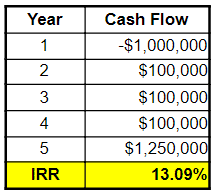When soliciting capital from potential investors, commercial real estate transaction sponsors—such as private equity firms and fund managers—like to advertise their success in previous deals, along with the potential returns for the one for which they’re seeking capital. One of the ways they do this is by stating a targeted internal rate of return (IRR).
In this article, FNRP explains what is the internal rate of return, how IRR can be manipulated, and why IRR manipulation matters.
What is the Internal Rate of Return?
IRR is the rate of return on each dollar invested, for each period of time it is invested in. IRR is often used as a proxy for the interest rate, and mathematically, it is calculated as the discount rate that sets the Net Present Value (NPV) of all future cash flows (positive or negative) equal to zero.
As a tool for measuring returns, IRR’s strength is that it allows for the comparison of investments between different asset classes as long as they have the same hold period. In addition, IRR accounts for the Time Value of Money, which is the idea that a dollar today is worth more than a dollar in the future due to its ability to earn interest. This point is key because IRR calculations are heavily dependent upon the timing of a property’s cash flows. To illustrate this point, consider the following series of cash flows:

This is the exact same series of cash flows, however, they are in a different order. The IRR for Cash Flow 1 is 14.54%, while the IRR for Cash Flow 2 is 13.09%. So why does Cash Flow 1 have a higher IRR? Because there is a larger cash flow that occurs earlier in the holding period. And because the IRR calculation assumes that this can be continually reinvested, it has more time to earn interest. This key concept underscores one of the major ways that the IRR metric can be manipulated.
How IRR Can Be Manipulated
The primary way that IRR can be manipulated is through the timing of cash flows. One of the most notorious ways that managers do this is through the use of subscription credit lines. The details can get a bit tricky, but the basic concept is this:
Private equity funds and managers work with banks to obtain a line of credit that is secured by the capital commitments to their fund. For example, suppose a manager has investor commitments for $100 million in capital to their fund. Instead of collecting that capital, the fund manager can borrow $60 million against these commitments, and can always issue a capital call to repay their borrowings. Funds from the line of credit are used to close quickly on deals, which can delay capital calls for years. As a further example, assume that a manager pays $1 million for a property and funds the deal with investor capital at the time of closing. The property returns $100,000 annually and is sold for $1.25M in year 5. The cash flows may look like this:

This deal has an IRR of 13.09%, which is very respectable. Now assume the same deal, but the manager funds the purchase on their credit line and does not call the capital from investors until year 3 of the 5-year holding period. The cash flows would look like this:

The IRR in this series is 16.92%, which implies a higher return over the first example. But the manager hasn’t actually done anything to add value to this deal; the manager has only manipulated the timing of the cash flows to make the IRR—and investment returns—appear to be higher.
For individuals interested in real estate investing and looking to allocate their capital to an investment manager, they should pay close attention to how IRR is calculated.
Why IRR Manipulation Matters
Most commercial real estate investment returns follow a “waterfall” distribution model. This means that the sponsor (the “general partner”) and the investor(s) (the “limited partners”) each make an upfront equity investment. Property cash flow is split between the two parties based on preset return “hurdles,” which are usually measured using IRR. The higher the IRR the transaction sponsor is able to deliver, the higher the share of cash flow they are entitled to. Thus, it can be in their best interest to skew IRR higher because it can earn them a bigger share of the cash flow pie.
Summary & Conclusions
The important point is that each individual investor has a responsibility to do a significant amount of their own due diligence prior to making an investment decision. This due diligence includes investigating the transaction sponsor’s background, experience, prior investment performance, planned investment period, and exactly how their return metrics are calculated. When reviewing the IRR calculation (if it is used), investors should be particularly aware of the timing of the property’s cash flows to ensure the calculation is not manipulated to skew the result higher.
Interested In Learning More?
First National Realty Partners is one of the real estate industry’s leading private equity commercial real estate investment firms. We leverage our decades of expertise and our available liquidity to find world-class, multi-tenanted assets below intrinsic value. In doing so, we seek to create superior long-term, risk-adjusted returns for our investors while creating strong economic assets for the communities in which we invest.
If you are an Accredited Investor and would like to learn more about our investment opportunities, contact us at (800) 605-4966 or ir@fnrpusa.com for more information.


